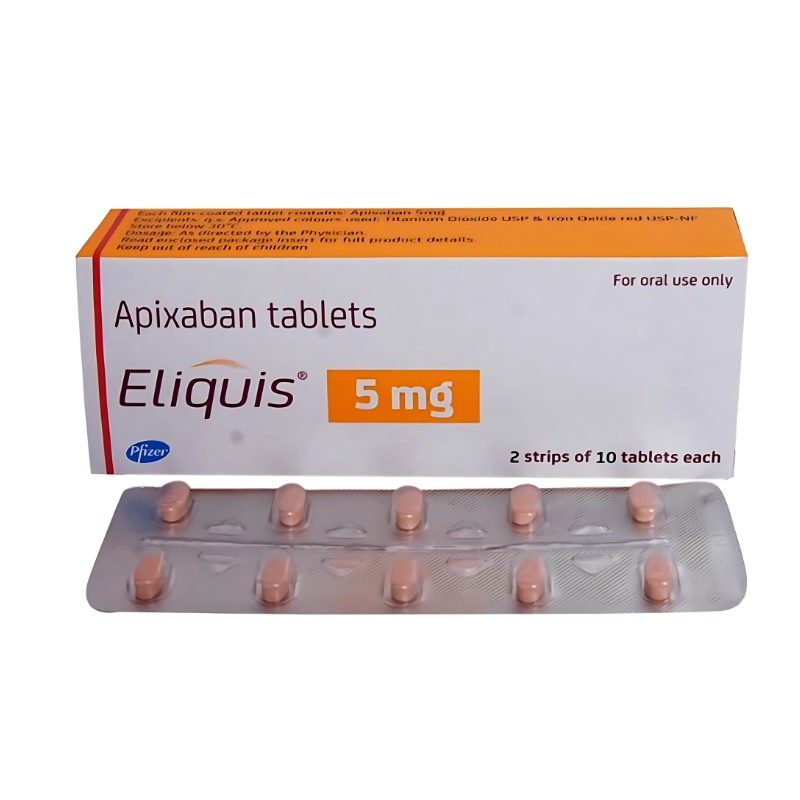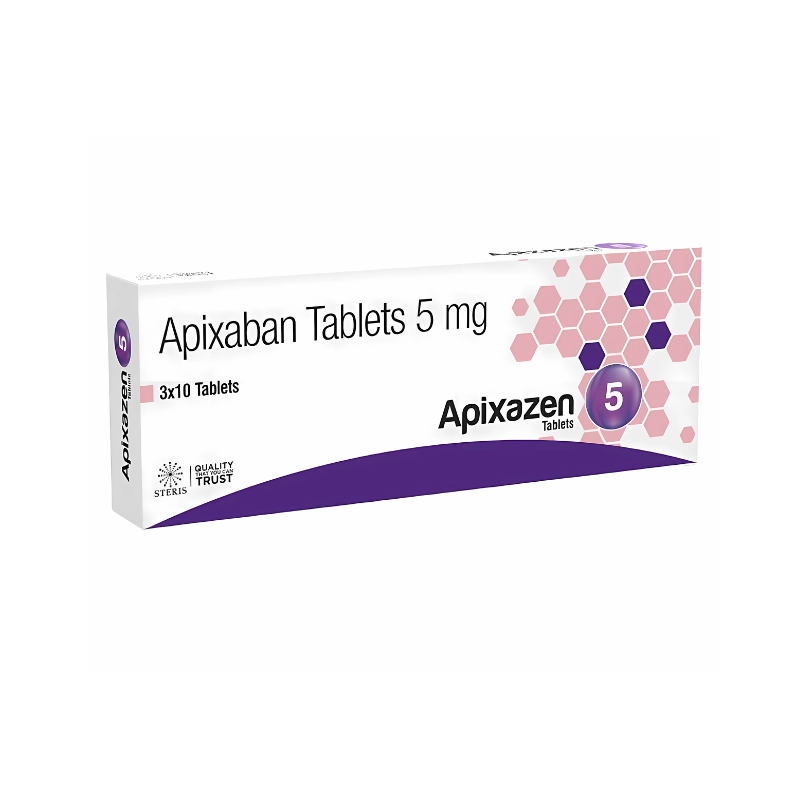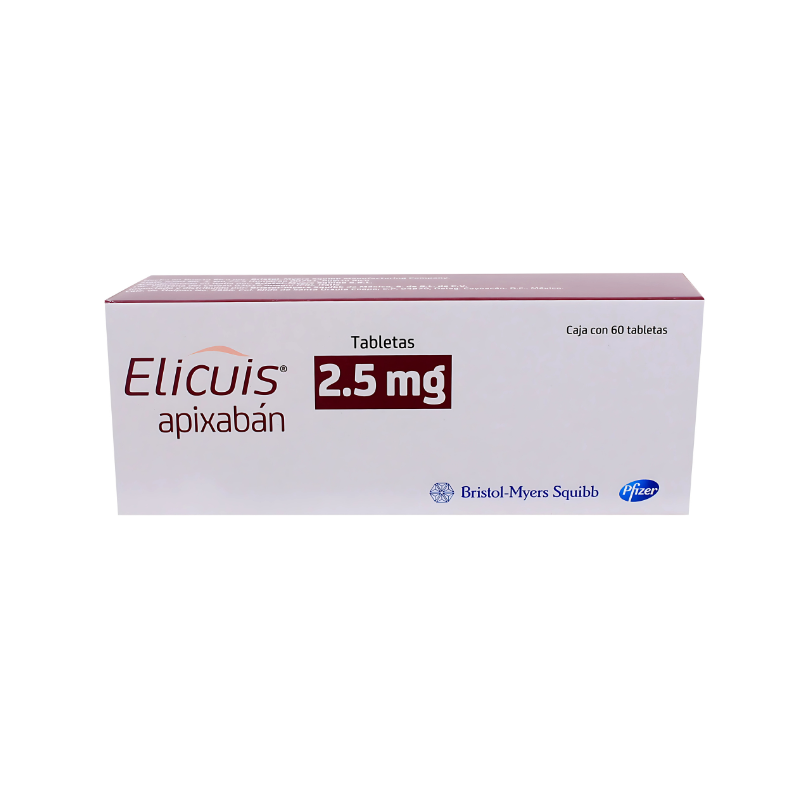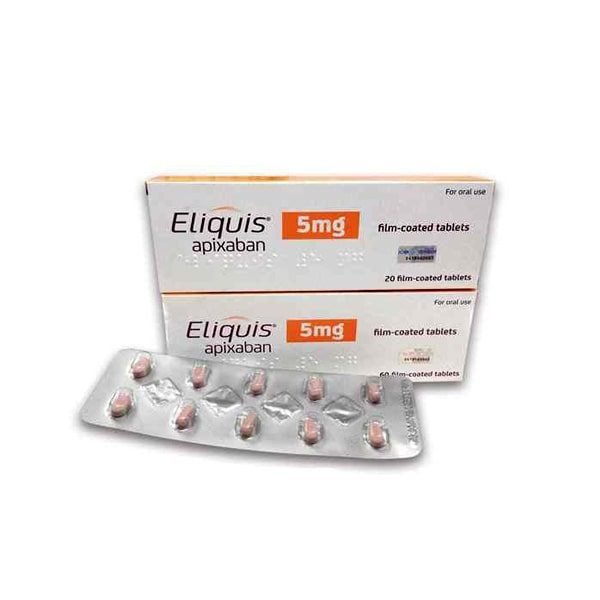Eliquis 5 mg (Apixaban)
$100.00 – $390.00Price range: $100.00 through $390.00
Eliquis 5 mg contains Apixaban, an anticoagulant used to prevent blood clots, stroke, and deep vein thrombosis in patients with atrial fibrillation or after surgery.
Eliquis 5 mg Tablet is a prescription anticoagulant medication containing Apixaban 5 mg, manufactured by Bristol-Myers Squibb in collaboration with Pfizer. Available in blisters of 10, 14, or 60 film-coated tablets, it is a direct factor Xa inhibitor used to prevent and treat blood clots in various conditions. It is primarily indicated for reducing stroke risk in nonvalvular atrial fibrillation, treating deep vein thrombosis (DVT) and pulmonary embolism (PE), and preventing their recurrence. The 5 mg dose is standard for most indications unless specific risk factors (e.g., age ≥80 years, weight ≤60 kg, or serum creatinine ≥1.5 mg/dL) require the 2.5 mg dose. Eliquis 5 mg requires a doctor’s prescription due to bleeding risks and drug interactions.
Uses
Eliquis 5 mg Tablet is used for:
-
Preventing stroke and systemic embolism in adults with nonvalvular atrial fibrillation (without specific risk factors requiring 2.5 mg)
-
Treating acute deep vein thrombosis (DVT) and pulmonary embolism (PE) in adults, typically for 6 months
-
Preventing recurrent DVT and PE after initial treatment in adults
-
Supporting treatment of venous thromboembolism in specific cases, as determined by a healthcare provider
Side Effects
Eliquis 5 mg Tablet may cause:
-
Common: Bleeding (e.g., bruising, nosebleeds, gum bleeding), anemia, nausea, contusion, post-hemorrhagic anemia
-
Rare: Bleeding around the spine (with spinal/epidural procedures), allergic reactions (e.g., rash, itching, swelling), gastrointestinal bleeding, hematuria
-
Serious: Severe bleeding (e.g., intracranial, gastrointestinal, or requiring transfusion), life-threatening bleeding (rarely fatal), spinal/epidural hematoma (risk of paralysis with spinal procedures)
Seek immediate medical help for severe symptoms like uncontrolled bleeding, blood in urine/stool, severe headache, or signs of allergic reaction (e.g., difficulty breathing). Contact a doctor if side effects persist or if you fall/injure yourself, especially head injuries.
How to Use
-
Dosage: Take one 5 mg tablet twice daily, as prescribed. For nonvalvular atrial fibrillation, 5 mg twice daily is standard unless risk factors (age ≥80 years, weight ≤60 kg, or serum creatinine ≥1.5 mg/dL) require 2.5 mg twice daily. For DVT/PE treatment, take 10 mg twice daily for 7 days, then 5 mg twice daily for 6 months. For recurrent DVT/PE prevention, transition to 2.5 mg twice daily after 6 months if prescribed.
-
Administration: Swallow the tablet whole with water, with or without food, at the same times daily (e.g., morning and evening). If swallowing is difficult, tablets may be crushed and mixed with water, 5% dextrose in water (D5W), apple juice, or applesauce and taken immediately. For nasogastric tube use, crush and suspend in 60 mL of water or D5W, followed by a 20 mL flush.
-
Missed Dose: Take the missed dose as soon as remembered on the same day, then resume twice-daily dosing. Do not double the dose.
-
Overdose: Seek immediate medical help or call Poison Help (1-800-222-1222) for symptoms like severe bleeding. An antidote (Andexanet alfa) is available for life-threatening bleeding.
How Tablet Works
Apixaban, the active ingredient in Eliquis 5 mg, is a direct factor Xa inhibitor that blocks factor Xa, a key enzyme in the blood clotting cascade. By inhibiting factor Xa, Apixaban prevents thrombin formation and subsequent clot development, reducing the risk of stroke, systemic embolism, DVT, and PE. It has ~50% bioavailability, reaches peak concentration in 3–4 hours, and has a half-life of ~12 hours, with effects persisting for ~24 hours after the last dose. Apixaban is metabolized primarily via CYP3A4 and excreted via renal (25–29%) and fecal (56%) pathways, with 50% as unchanged drug.
Safety Advice
-
Allergies: Avoid if allergic to Apixaban or any tablet components (e.g., lactose, microcrystalline cellulose, yellow iron oxide).
-
Health Conditions: Contraindicated in active bleeding, severe liver disease (Child-Pugh C), or severe renal impairment (eGFR <15 mL/min or dialysis). Use cautiously in mild/moderate renal impairment (eGFR 15–29 mL/min) or mild/moderate liver impairment (Child-Pugh A/B).
-
Drug Interactions: Avoid with strong CYP3A4 and P-gp inhibitors (e.g., ketoconazole, ritonavir) at 5 mg twice daily, as they increase bleeding risk. Reduce to 2.5 mg twice daily or avoid with strong CYP3A4 inducers (e.g., rifampin, carbamazepine), as they reduce efficacy. Increased bleeding risk with other anticoagulants, aspirin, SSRIs/SNRIs, or NSAIDs. Inform your doctor of all medications/supplements.
-
Pregnancy/Breastfeeding: Not recommended due to potential fetal harm and unknown excretion in breast milk. Consult a doctor if pregnant or breastfeeding.
-
Driving: No significant impact on driving ability.
-
Alcohol: Limit alcohol, as it may increase bleeding risk.
-
Storage: Store at room temperature (20–25°C), with short-term exposure to 15–30°C allowed. Keep out of reach of children.
-
Children: Not recommended; dosing for venous thromboembolism in children (≥2.6 kg) is weight-based and determined by a doctor.
| Tablet/s | 30 Tablet/s, 60 Tablet/s, 90 Tablet/s, 120 Tablet/s |
|---|
Be the first to review “Eliquis 5 mg (Apixaban)” Cancel reply
You must be logged in to post a review.
Related products
Anti Coagulant
Anti Coagulant
Anti Coagulants






Reviews
There are no reviews yet.